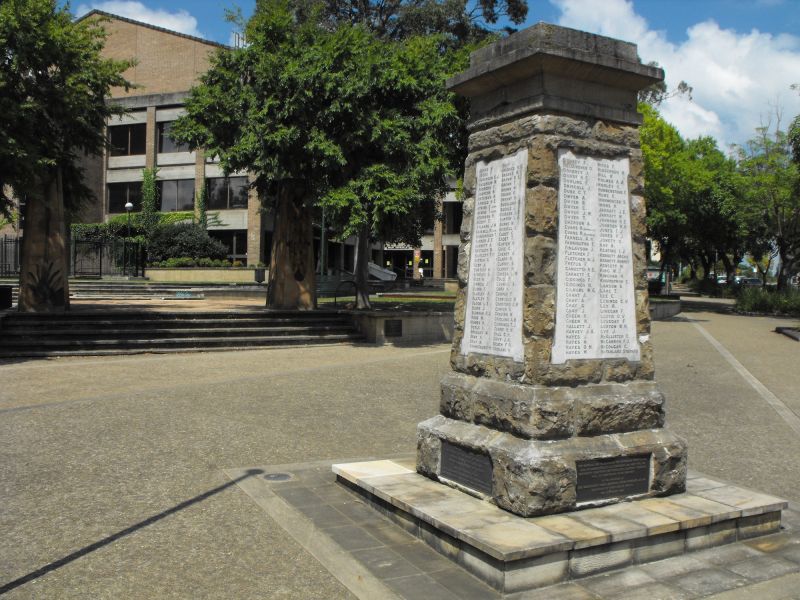First To Serve
Two names that are on the Sutherland War Memorial in Sydney are W Clarke and O N Hayes. William Edward Clarke of Sutherland and Oswald Norman Hayes of Como were amongst the first Australians to enlist during the First World War. William Clarke, aged 20, tailor’s presser, enlisted on 11 August 1914 and Oswald Hayes, aged 24, wool classer, enlisted on 12 August 1914. Hayes’s enlistment date was later changed to 11 August 1914 on his enlistment papers. Both these young men joined the Australian Naval and Military Expeditionary Force (ANMEF). Hayes was in C Company and Clarke was in D Company.
At the outbreak of war on 4 August 1914 Germany had a number of colonies in the south and central parts of the Pacific Ocean. On 6 August 1914 the British Government contacted the Australian and New Zealand Governments and requested them to seize control of these German territories. The Australian Government quickly responded, especially as German New Guinea was on the country’s doorstep, and formed a military force of 1,500 servicemen, comprising 1,000 soldiers from NSW and 500 naval reservists from NSW & other States. This became the ANMEF.
On 18 August 1914 around 1,000 soldiers marched through the streets of Sydney to Fort Macquarie, where the Sydney Opera House is today. They then were taken by ferry to Cockatoo Island where the next day they left Sydney on the HMAT A35 Berrima. The men only found out where they were going when they were out at sea. They stopped at Palm Island for jungle training before travelling to Port Moresby in the Australian territory of Papua and then onto German New Guinea in early September 1914.
The march through the streets of Sydney was reported enthusiastically by the Sydney Morning Herald on 19 August 1914.
The Australian War Memorial has in its collection a photo of the ANMEF men aboard the ferry Kulgoa as it left Fort Macquarie on its way to Cockatoo Island.
Australia’s first battle in 1914 occurred when troops from the ANMEF attacked the German forces near Rabaul, on the island of New Britain, on 11 September 1914, in order to capture and destroy the very powerful German wireless station at Bitapaka. This they did with the loss of 6 ANMEF servicemen and 4 wounded. 31 men from the German side were killed, the majority being the Melanesian police.
There is no record of William Clarke and Oswald Hayes being involved in any fighting in German New Guinea. However, many of the men in the ANMEF were infected with malaria. Clarke was infected with malaria in November 1914 and Hayes was probably infected too. The ANMEF soon took control of German New Guinea and this unit of the ANMEF men returned to Australia in January 1915. The men were discharged from the ANMEF at the beginning of March 1915.
It would be true to say that most of the 1914 ANMEF men were very keen to continue their service in the war and many joined the Australian Imperial Force (AIF) quite quickly after their discharge from the ANMEF. This certainly applied to William Clarke and Oswald Hayes. Both Clarke and Hayes were discharged from the ANMEF on 4 March 1915 and within two weeks they enlisted in the AIF. William Clarke enlisted in the 13th Infantry Battalion (reinforcements) and Oswald Hayes enlisted in the 1st Light Horse Regiment (reinforcements). Hayes left Newcastle NSW with his unit, on board the HMAT A41 Bakara, on 22 May 1915. Clarke left Sydney NSW with his unit, on board the HMAT A9 Shropshire, on 20 August 1915.
William Clarke suffered very badly from malaria throughout his time in the 13th Battalion. He was hospitalised on a number of occasions for malaria. He was returned to Australia in December 1915 as medically discharged due to his malaria and then sent back to Egypt from Australia in May 1916. Medically discharged again due to malaria in November 1916 and sent back to Australia on 13 February 1917. Finally discharged from the AIF on 21 August 1917. His military rank on discharge was Corporal. In a medical report, dated 19 November 1916, which is in his service records, it is stated that William Clarke was “Pale, pasty and anaemic – Has had frequent attacks of Malaria for 2 years – Was returned to Australia for discharge but picked up and was sent to Egypt. Has been in and out of Hospital ever since i.e. since May 14th 1916. Is debilitated. Recommend: Discharge as permanently unfit.” This recommendation was accepted. After his discharge from the AIF Clarke was employed as a corporal in the Office of Intelligence & Regimental Security, Home Office, in Sydney. William Clarke died on 2 April 1919 from pneumonic influenza at the Coast Hospital (which became Prince Henry Hospital), Little Bay, Sydney. He was buried at the Rookwood Necropolis, Rookwood, Sydney, NSW. His name is on the Australian War Memorial’s Roll of Honour in Canberra, on panel 68 in the Commemorative Area of the AWM, one of 61,514 names in the WWI section of the Roll of Honour at the AWM in Canberra. Also, William Clarke was one of nearly 15,000 Australians who lost their lives in 1919 due to the Spanish Flu Epidemic.
Oswald Hayes also was hospitalised during his service in the AIF because of malaria. However, he was able to continue with his war service with the 1st Light Horse Regiment until 1918. Hayes saw active service at Gallipoli and in the Middle East. He was promoted to Sergeant on 1 January 1916 and after being selected for officer training was promoted to 2nd Lieutenant on 22 October 1917. Oswald Hayes was wounded in the right leg during fighting on 3 November 1917. This would have been when the 1st Light Horse Regiment was fighting in the Third Battle for Gaza, 27 October – 7 November 1917. Gaza fell to the Allies on 7 November 1917. Oswald Hayes left the Middle East via Suez on 23 December 1918, on the grounds of invalidity (malaria & leg wound), for Australia. His military rank on discharge was Lieutenant.
After the war Oswald Hayes became an auctioneer and commissioner agent. In August 1929 he was reported missing to NSW Police by his wife, Eva Hayes. On 1st August 1929 he left his home at Baradine NSW after informing his wife that he was going to Walgett to meet two buyers and take them to near Dirranbandi, Queensland, to inspect a property and would return home on 3rd August. It was later confirmed that Oswald Hayes instead went in the opposite direction, to Coonabarabran where he stated that he intended to go to Inverell. Hayes was last seen on 2nd August 1929 at Coolah where he told people he was travelling to Merriwa to meet buyers who he was going to take to Glen Innes to inspect a property. A check with the National Archives of Australia who now holds the Repatriation & Service Records of the Australian servicemen & women from the First World War revealed that Oswald Hayes made a claim for the Service Pension in October 1943 on the grounds on invalidity. He had suffered two strokes and had spend seven weeks in the Soldiers Section of the Perth Hospital. In his claim he stated that he was single man. Oswald Hayes was granted the Service Pension on the grounds of invalidity on 2 December 1943. He was admitted to the Sunset Old Peoples Home (which was an aged care facility) at Nedlands, Perth, on 13 April 1944 and died there on 12 August 1944.
Sources: Sutherland War Memorial; WWI Service Records, National Archives of Australia, Discovering Anzacs website; AWM Roll of Honour (2013), National Library of Australia’s TROVE website for newspapers; AWM website for ANMEF history, including 1914 ANMEF Unit Embarkation Nominal Roll & photo of ferry, Kulgoa - 13th Infantry Battalion history – 1st Light Horse Regiment history – Roll of Honour; Missing Notices, NSW Police Gazette & Weekly Record of Crime, Wednesday 21st August 1929; and Pension File Number 491749, Commonwealth Department of Repatriation & Compensation, NAA: PP 13/1, C30897.
PS. 1. Craig Tibbitts, AWM historian, in an article for the AWM’s Wartime publication, entitled Casualties of War under the heading of Disease states that despite the ANMEF men taking quinine, by November 1914 some 60% of the ANMEF troops at Rabaul and Herbertshobe were infected with malaria. Malaria could be difficult to cure entirely and relapses were common. Most of the Australian troops during WWI who suffered from malaria and died, died from respiratory tract infections, commonly influenza and pneumonia.
2. In April 1919 when William Clarke died from pneumonic influenza Sydney was in the grip of a flu epidemic as reported in the Sun newspaper on 22 April 1919. For the last 24 hours in Sydney area there were 26 deaths and 155 new cases reported. There were 8 deaths and 44 new case at the Coast Hospital. The Daily Observer newspaper in Tamworth on 7 April 1919 also reported that the death tally from the flu in Sydney for the last 24 hours was 19 with 55 new cases.
- National Archives of Australia's Discovering Anzacs website ( service records o… https://discoveringanzacs.naa.gov.au
 Patrick Bourke
Patrick Bourke